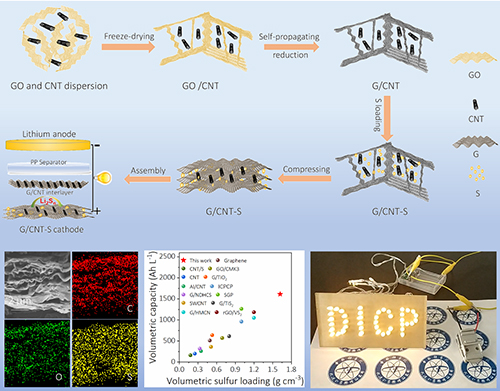
A research group led by WU Zhongshuai from the Dalian Institute of Chemical Physics (DICP) of the Chinese Academy of Sciences developed high volumetric-energy-density and long-life lithium sulfur (Li-S) batteries based on the free-standing, densely compact, and integrated cathode.
These Li-S batteries are derived from three-dimensional (3D) interconnected porous graphene/CNT aerogels, simultaneously serving as sulfur host and interlayer. Their findings were published in Nano Energy.
Lithium-sulfur (Li-S) batteries, as one highly competitive alternative for commercially available high-energy-density lithium metal batteries, have drawn considerable attentions on account of high theoretical gravimetric and volumetric energy density.
However, the practical applications of Li-S batteries have been hampered by several issues, including low mass densities of nano sulfur, intrinsically poor electrical conductivities of sulfur, large volume expansion of sulfur particle during cycling, and shuttling effect of lithium polysulfide, all of which result in low volumetric energy density and limited cyclability of Li-S batteries.
Hence, improving the gravimetric and volumetric energy density at the same time, as well as prolonging the cycle stability of the Li-S batteries, is the bottleneck of the applied research of Li-S batteries.

Schematic of 3D graphene/carbon nanotube aerogels for ultrahigh volumetric-energy-density lithium-sulfur batteries. (Image by SHI Haodong and HOU Xiaocheng)
The scientists developed a free-standing, compact, conductive and integrated cathode, constructed by compressing graphene/carbon nanotubes aerogels, simultaneously serving as bi-functionalities of binder- and metal-current-collector-free sulfur host and interlayer for Li-S batteries.
The integrated cathode displayed high compaction density, outstanding mechanical flexibility and high electrical conductivity, which could endow the cathode with ultrahigh volumetric mass density, volumetric-energy-density, and exceptionally long-term cycling stability with an extremely low decay rate over 500 cycles at 2C.
This proposed integration cathode strategy would open numerous opportunities for constructing binder-free, current-collector-free, high-sulfur-loading and compact cathodes toward high-volumetric-energy-density and flexible Li-S batteries.
This work was supported by National Natural Science Foundation of China, National Key R&D Program of China, and Dalian National Laboratory For Clean Energy (DNL), CAS, etc.

86-10-68597521 (day)
86-10-68597289 (night)

86-10-68511095 (day)
86-10-68512458 (night)

cas_en@cas.cn

52 Sanlihe Rd., Xicheng District,
Beijing, China (100864)

